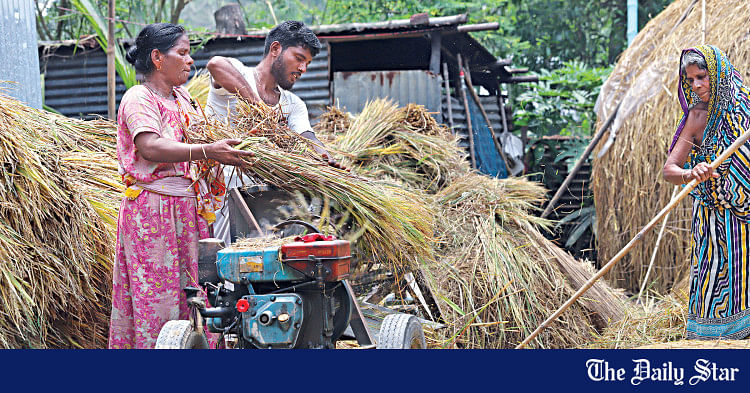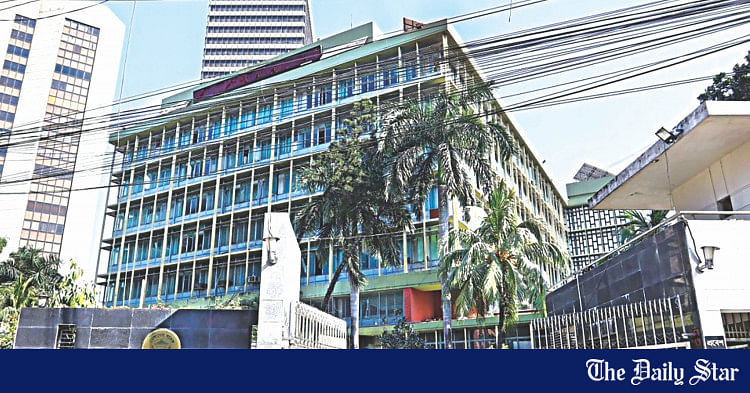Saif
Senior Member
- Joined
- Jan 24, 2024
- Messages
- 15,898
- Likes
- 7,990
- Nation

- Axis Group


How women are revolutionising our agriculture
Women are an indispensable part of our agricultural workforce.
How women are revolutionising our agriculture

The ‘feminisation of agriculture’ is a growing phenomenon, as increasing numbers of women assume leadership roles in the sector. FILE PHOTO: REUTERS
In Bangladesh's economy, agriculture plays a vital role in providing livelihoods for around 45.33 percent of the total labour force and contributing 11.38 percent to the Gross Domestic Product (GDP). Women are an indispensable part of the agricultural workforce. According to the Food and Agriculture Organization (FAO), women's agricultural work spans not only production but also post-harvest activities, such as processing, packaging, and marketing. These activities are essential in ensuring food security and promoting economic sustainability in rural communities. They are also associated with safe food production. However, despite their significant contributions, women's roles in agriculture are often underappreciated and undervalued, with numerous challenges, such as limited access to land, financial services, training, and modern technology, primarily due to entrenched social norms and gender biases.
According to the Labour Force Survey (LFS) 2022 of the Bangladesh Bureau of Statistics (BBS), the participation of women aged 15 and above in agriculture is 26.2 percent, while the rate for their male counterparts is 19.2 percent.
The country's highest employment-creating sector is gradually becoming dominated by females, with their engagement in agriculture and every agricultural subsector, including poultry and livestock, fisheries, and horticulture. The transformation that has been occurring for over a decade has already had a positive impact on the overall participation of women in the labour force in farming, while men are switching to urban services. The migration of men to urban areas in search of higher-paying jobs, as traditional farming becomes less lucrative, particularly in crop production, has left women to manage agricultural activities to support their families' income.
The "feminisation of agriculture" is a growing phenomenon, as increasing numbers of women assume leadership roles in the sector. This shift can be attributed to several factors, such as livestock rearing, poultry farming, post-harvest operations, and seed preservation. Approximately 63 percent of women in rural areas are involved in preserving local seeds, which ensures biodiversity and sustainability in farming practices.
Women are predominantly responsible for managing cattle, poultry, and goats, which play a critical role in household nutrition and income. They are also essential in managing post-harvest activities, such as winnowing, sorting, primary processing, and storing crops. By managing diverse agricultural activities, women contribute to the availability of nutritious food, improving the health and well-being of their families.
Land ownership is a key determinant of agricultural production, yet women in Bangladesh face substantial challenges when it comes to owning or inheriting land.
According to the World Bank, only around 13 percent of women have sole or joint ownership of agricultural land, compared to 70 percent of men. For economic empowerment, Bangladeshi women need equal property rights. Cultural norms often prioritise male inheritance, and property laws frequently favour men, leaving women with little legal control over the land they work. This lack of control means women are unable to make independent decisions about farming practices, investments, or business opportunities. Furthermore, they are less likely to receive financial support from banks, which require land as collateral for loans.
Women in Bangladesh are also lagging in financial credit. The International Fund for Agricultural Development (IFAD) reports that women in rural Bangladesh are 20 percent less likely to access formal credit than men, primarily due to their lack of land ownership and social exclusion from financial institutions. This financial exclusion restricts women's ability to invest in technology or agricultural inputs, thus limiting their productivity and income potential.
Access to modern agricultural inputs and technology is also crucial for enhancing productivity. However, many women in rural Bangladesh are unable to access new technologies due to gender biases, lack of training, and limited mobility. According to a report from the Bangladesh Rural Development Board (BRDB), less than 30 percent of rural women have received agricultural training, compared to over 70 percent of men. Without access to modern farming techniques, women remain stuck in subsistence farming, unable to increase yields or improve efficiency.
To unlock the full potential of women in agriculture and address these challenges, several strategies must be implemented, such as legal reforms to ensure that women have equal access to land and property rights. The government should promote joint land ownership models, where both men and women in a household have legal control over the land. Creating gender-sensitive land registration processes and ensuring that women's names appear on land titles would allow women to secure loans and make independent decisions about farming. The World Bank has suggested that empowering women through secure land tenure could significantly increase agricultural productivity, as women tend to reinvest their earnings into their families and communities.
To enable women farmers to invest in modern agricultural practices, access to credit must be improved. Financial institutions should develop gender-sensitive loan products tailored to the needs of women farmers, with lower collateral requirements and flexible repayment terms. The microcredit programme, which Bangladesh has pioneered, provides some microfinance loans to rural women. Additionally, the Bangladesh Bank should encourage gender-responsive banking practices and create schemes that prioritise women's access to financial resources.
Access to modern agricultural inputs and technology is essential for increasing productivity. Technological innovation plays a significant role in alleviating the labour-intensive nature of agriculture. Several women-friendly technologies have been introduced in Bangladesh to ease the burden of agricultural work. Fodder chopper machines simplify the chopping of grass for cattle feed, saving women valuable time and effort. This is a prime example of women-friendly technology that is making a significant impact on the lives of female farmers in rural Bangladesh. Hermetic Storage Bags provide an efficient and safe method for storing seeds, reducing the risks of pest infestations and moisture-related losses. They have proven to be especially beneficial for women who are responsible for seed preservation. BAU-STR Dryers, developed by Bangladesh Agricultural University, reduce grain loss during the drying process to 0.5 percent, compared to the 3-4 percent loss using traditional methods. The dryers are user-friendly and help maintain the quality of grain.
Paddy, wheat, and maize threshing are mechanised, which is considered women-friendly and affordable. Women's groups may organise themselves as service providers. Small-scale food processing, such as milk-based cheese, sweetmeats, and pickles, may be organised through self-help groups, and relevant micro-enterprise organisations may support them with skill development and business opportunities.
The government and NGOs should subsidise agricultural inputs, such as fertilisers, high-yielding seed varieties, and irrigation equipment for women farmers, including solar panel-based irrigation. Agricultural extension services should be restructured to be more inclusive of women, offering training programmes that cater to their specific needs. Female extension officers can help connect women farmers to resources and provide tailored advice on farming techniques, climate-smart practices, and pest management.
On a positive note, women are increasingly participating in agricultural education, with about 40 percent of women enrolled in universities and training institutes. Thirty percent of women are engaged in agricultural extension, and 12 percent in agricultural research. This may be exploited in women-friendly agricultural programmes to intensify agricultural production and farm profitability. The Department of Agricultural Extension has made it mandatory to include women in forming farmers' clubs and farm schools. The farming system research approach has mainstreamed nutrition and safe food production, and women are participating in the programmes and receiving training on safe and nutritious production.
Education and training are crucial for enhancing women's agricultural productivity. Agricultural training programmes should be designed to address the specific needs of women, offering flexible schedules and locations. In addition to farming skills, women should be trained in business management, marketing, and financial literacy to help them manage their agricultural enterprises effectively.
For sustainable growth in agriculture, women must be included in decision-making processes at all levels. Encouraging women to take leadership roles in agricultural cooperatives and community organisations will ensure their voices are heard in policy and programme development. At the national level, policymakers should work to integrate women's perspectives into agricultural planning, ensuring that policies are designed to address the specific needs of female farmers.
The feminisation of agriculture in Bangladesh and South Asia is transforming the agri-food system. Women's participation has been recognised in all relevant policies. Accordingly, several programmes are being implemented—however, such programmes should be well coordinated. A favourable public policy environment and women-friendly farm operations need to be synchronised with an adequate R&D system. The organised farming and post-production system should be supported in entrepreneurship development. Capacity building of the farming community will be a prime task to make them a more productive segment of society.
Dr Susmita Das is principal documentation officer at Bangladesh Agricultural Research Council.
The ‘feminisation of agriculture’ is a growing phenomenon, as increasing numbers of women assume leadership roles in the sector. FILE PHOTO: REUTERS
In Bangladesh's economy, agriculture plays a vital role in providing livelihoods for around 45.33 percent of the total labour force and contributing 11.38 percent to the Gross Domestic Product (GDP). Women are an indispensable part of the agricultural workforce. According to the Food and Agriculture Organization (FAO), women's agricultural work spans not only production but also post-harvest activities, such as processing, packaging, and marketing. These activities are essential in ensuring food security and promoting economic sustainability in rural communities. They are also associated with safe food production. However, despite their significant contributions, women's roles in agriculture are often underappreciated and undervalued, with numerous challenges, such as limited access to land, financial services, training, and modern technology, primarily due to entrenched social norms and gender biases.
According to the Labour Force Survey (LFS) 2022 of the Bangladesh Bureau of Statistics (BBS), the participation of women aged 15 and above in agriculture is 26.2 percent, while the rate for their male counterparts is 19.2 percent.
The country's highest employment-creating sector is gradually becoming dominated by females, with their engagement in agriculture and every agricultural subsector, including poultry and livestock, fisheries, and horticulture. The transformation that has been occurring for over a decade has already had a positive impact on the overall participation of women in the labour force in farming, while men are switching to urban services. The migration of men to urban areas in search of higher-paying jobs, as traditional farming becomes less lucrative, particularly in crop production, has left women to manage agricultural activities to support their families' income.
The "feminisation of agriculture" is a growing phenomenon, as increasing numbers of women assume leadership roles in the sector. This shift can be attributed to several factors, such as livestock rearing, poultry farming, post-harvest operations, and seed preservation. Approximately 63 percent of women in rural areas are involved in preserving local seeds, which ensures biodiversity and sustainability in farming practices.
Women are predominantly responsible for managing cattle, poultry, and goats, which play a critical role in household nutrition and income. They are also essential in managing post-harvest activities, such as winnowing, sorting, primary processing, and storing crops. By managing diverse agricultural activities, women contribute to the availability of nutritious food, improving the health and well-being of their families.
Land ownership is a key determinant of agricultural production, yet women in Bangladesh face substantial challenges when it comes to owning or inheriting land.
According to the World Bank, only around 13 percent of women have sole or joint ownership of agricultural land, compared to 70 percent of men. For economic empowerment, Bangladeshi women need equal property rights. Cultural norms often prioritise male inheritance, and property laws frequently favour men, leaving women with little legal control over the land they work. This lack of control means women are unable to make independent decisions about farming practices, investments, or business opportunities. Furthermore, they are less likely to receive financial support from banks, which require land as collateral for loans.
Women in Bangladesh are also lagging in financial credit. The International Fund for Agricultural Development (IFAD) reports that women in rural Bangladesh are 20 percent less likely to access formal credit than men, primarily due to their lack of land ownership and social exclusion from financial institutions. This financial exclusion restricts women's ability to invest in technology or agricultural inputs, thus limiting their productivity and income potential.
Access to modern agricultural inputs and technology is also crucial for enhancing productivity. However, many women in rural Bangladesh are unable to access new technologies due to gender biases, lack of training, and limited mobility. According to a report from the Bangladesh Rural Development Board (BRDB), less than 30 percent of rural women have received agricultural training, compared to over 70 percent of men. Without access to modern farming techniques, women remain stuck in subsistence farming, unable to increase yields or improve efficiency.
To unlock the full potential of women in agriculture and address these challenges, several strategies must be implemented, such as legal reforms to ensure that women have equal access to land and property rights. The government should promote joint land ownership models, where both men and women in a household have legal control over the land. Creating gender-sensitive land registration processes and ensuring that women's names appear on land titles would allow women to secure loans and make independent decisions about farming. The World Bank has suggested that empowering women through secure land tenure could significantly increase agricultural productivity, as women tend to reinvest their earnings into their families and communities.
To enable women farmers to invest in modern agricultural practices, access to credit must be improved. Financial institutions should develop gender-sensitive loan products tailored to the needs of women farmers, with lower collateral requirements and flexible repayment terms. The microcredit programme, which Bangladesh has pioneered, provides some microfinance loans to rural women. Additionally, the Bangladesh Bank should encourage gender-responsive banking practices and create schemes that prioritise women's access to financial resources.
Access to modern agricultural inputs and technology is essential for increasing productivity. Technological innovation plays a significant role in alleviating the labour-intensive nature of agriculture. Several women-friendly technologies have been introduced in Bangladesh to ease the burden of agricultural work. Fodder chopper machines simplify the chopping of grass for cattle feed, saving women valuable time and effort. This is a prime example of women-friendly technology that is making a significant impact on the lives of female farmers in rural Bangladesh. Hermetic Storage Bags provide an efficient and safe method for storing seeds, reducing the risks of pest infestations and moisture-related losses. They have proven to be especially beneficial for women who are responsible for seed preservation. BAU-STR Dryers, developed by Bangladesh Agricultural University, reduce grain loss during the drying process to 0.5 percent, compared to the 3-4 percent loss using traditional methods. The dryers are user-friendly and help maintain the quality of grain.
Paddy, wheat, and maize threshing are mechanised, which is considered women-friendly and affordable. Women's groups may organise themselves as service providers. Small-scale food processing, such as milk-based cheese, sweetmeats, and pickles, may be organised through self-help groups, and relevant micro-enterprise organisations may support them with skill development and business opportunities.
The government and NGOs should subsidise agricultural inputs, such as fertilisers, high-yielding seed varieties, and irrigation equipment for women farmers, including solar panel-based irrigation. Agricultural extension services should be restructured to be more inclusive of women, offering training programmes that cater to their specific needs. Female extension officers can help connect women farmers to resources and provide tailored advice on farming techniques, climate-smart practices, and pest management.
On a positive note, women are increasingly participating in agricultural education, with about 40 percent of women enrolled in universities and training institutes. Thirty percent of women are engaged in agricultural extension, and 12 percent in agricultural research. This may be exploited in women-friendly agricultural programmes to intensify agricultural production and farm profitability. The Department of Agricultural Extension has made it mandatory to include women in forming farmers' clubs and farm schools. The farming system research approach has mainstreamed nutrition and safe food production, and women are participating in the programmes and receiving training on safe and nutritious production.
Education and training are crucial for enhancing women's agricultural productivity. Agricultural training programmes should be designed to address the specific needs of women, offering flexible schedules and locations. In addition to farming skills, women should be trained in business management, marketing, and financial literacy to help them manage their agricultural enterprises effectively.
For sustainable growth in agriculture, women must be included in decision-making processes at all levels. Encouraging women to take leadership roles in agricultural cooperatives and community organisations will ensure their voices are heard in policy and programme development. At the national level, policymakers should work to integrate women's perspectives into agricultural planning, ensuring that policies are designed to address the specific needs of female farmers.
The feminisation of agriculture in Bangladesh and South Asia is transforming the agri-food system. Women's participation has been recognised in all relevant policies. Accordingly, several programmes are being implemented—however, such programmes should be well coordinated. A favourable public policy environment and women-friendly farm operations need to be synchronised with an adequate R&D system. The organised farming and post-production system should be supported in entrepreneurship development. Capacity building of the farming community will be a prime task to make them a more productive segment of society.
Dr Susmita Das is principal documentation officer at Bangladesh Agricultural Research Council.










































